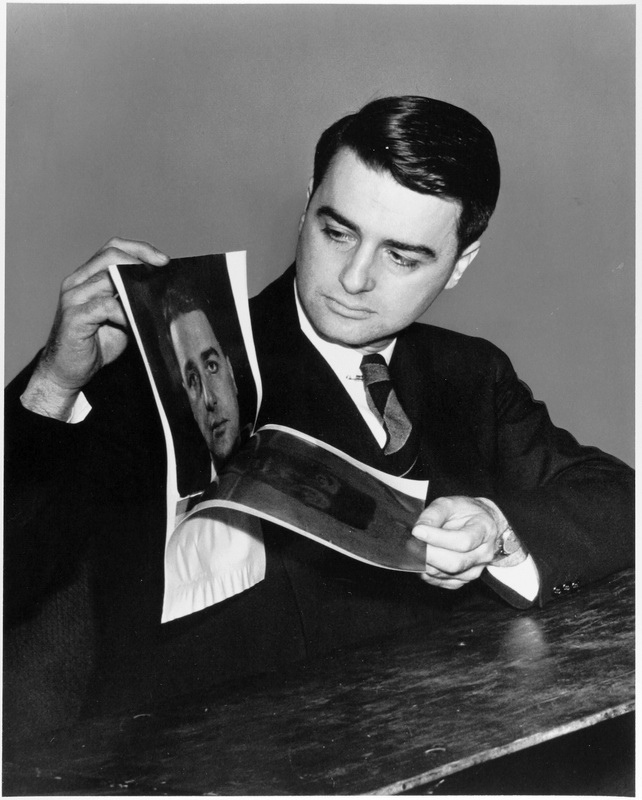In 1943, Edwin H. Land’s three-year-old daughter asked him
why she had to wait so long to see their family photos (Kaplan). This inspired him to
pursue the embodiment of an instantaneous photographic process. Reportedly,
Land figured out the basic concept of one-step photography in about an hour;
carrying out his idea and translating it into an operable product took a few
more years. He announced his new invention to the Optical Society of America in
1947 (The Polaroid Book 24; Spina)
and introduced his new camera, the Polaroid Land Model 95 in 1948 (Marien
362-363; Rosenblum 603). This state-of-the-art device cost about $95.00--which converts into about $860.00 today.
Land’s Polaroid process accomplished the long-sought-after
task of sensitizing and processing photographic film inside the camera. Although
it wasn’t the first piece of equipment with the ability to sensitize and
develop film inside it (Rosenblum 603), the Polaroid camera was the first with the ability to
instantly print photographs (“instantly” meant it took about one minute to
develop).
The general process is outlined by Rosenblum:
A large roll of print paper and a smaller roll of negative paper, connected by a leader, fitted into the top and bottom of the camera back. By means of the leader, the negative paper and the print paper were brought together and drawn between a pair of rollers, which broke a pod of processing chemicals, carried on the print strip, and spread its contents evenly between the two strips. After one minute, the finished print could be removed from the camera through a flap in the back (604).
Watch the following video to get a better idea of how this
original camera worked:
For the next couple of decades, Polaroid released around fifty new cameras, each further improving upon the structure, exposure time, flash systems, development timers, accessories, batteries, and film (The Polaroid Book 369-380). Finally, in 1972, the SX-70 camera was introduced. The SX-70 automatically ejected the color print from the camera immediately after the photo was taken. Although deceivingly compact, it included an automatic focus and an electronic flash, and the battery was integrated into the film pack (Rosenblum 603).
 | ||
| The Polaroid SX-70 |
Watch the following video to see an original SX-70 commercial. Pay particular attention to the segment between 4:43 and 9:55 for information about the inner-workings of the camera and how the mechanisms interact with the film.
Polaroid instant prints are most easily identified by their unique border. These border shapes served important purposes inside the camera, housing the pods that released the chemicals needed to develop the images. Additionally, prints were usually labeled on the back with either the Polaroid Corporation name or the name of the material used. For more tips on identifying instant prints, visit the Graphics Atlas website.
Polaroid instant prints are most easily identified by their unique border. These border shapes served important purposes inside the camera, housing the pods that released the chemicals needed to develop the images. Additionally, prints were usually labeled on the back with either the Polaroid Corporation name or the name of the material used. For more tips on identifying instant prints, visit the Graphics Atlas website.
 |
| Image from http://portroids.tumblr.com/post/3938865930/bradley-cooper-because-he-has-a-movie-coming |
 |
| Image from http://jkldesign.blogspot.com/2009/09/polaroid-fashion-fabulous.html |
Edwin Land’s Polaroid process made the instant photography
experience possible for everyone. (The
Polaroid Book 21). This new product not only improved the documentation of everyday life, it changed the fields of medicine, law enforcement, insurance, advertising, and fashion (Shpak). With the release
of the SX-70, the Polaroid process became a catalyst for color photographs to
take over black-and-white in the world of amateur photographers. Much of the
art world still remained partial to black-and-white photos, but Polaroids
charmed the general population--and slowly, artists followed--into the world of color (Marien 363).
 | ||
| Creator: Andy Warhol Title: Farah Diba Pahlavi (Queen of Iran) Date: March 1976 Retrieved from ARTstor |
 | |
| Creator: Andy Warhol Title: Shoes Date: 1980 Retrieved from ARTstor |
The Artist Support Program was started in the 1960s to assist emerging photographers as well as Polaroid in establishing a reputation. In exchange for their photographs and feedback, Polaroid would lend photographers the latest equipment. This helped Polaroid build up a collection of photographs and improve their products. Over one thousand photographers collaborated with Polaroid, including Ansel Adams and Andy Warhol (The Polaroid Book 24-29; Hitchcock).
Art photographers often manipulated and altered their Polaroids, using ink, fabric, and wooden and metal tools to change the appearance of images. For a demonstration of Polaroid manipulation, click here.
 | |
| An example of a manipulated SX-70 print Creator: Samaras, Lucas, 1936- Title: Photo-Transformation Date: November 1, 1973 Retrieved from ARTstor |
 |
| Creator: Barbara Kasten Title: Metaphase 5 Date: 1985 Retrieved from ARTstor |
There were further developments in instant
Polaroid products up until the 2000s, but unfortunately all instant film was
discontinued in 2008. There are a few groups worldwide attempting to invent
film that will be compatible with the original Polaroid equipment. The most
notable of these groups is The Impossible Project. You can find more
information about their efforts here.
__________________________
__________________________
Works Cited
Hitchcock,
Barbara. “Facts About the Polaroid Collections,” 21 Apr. 2010. Web. 25 Feb. 2013. <http://74.220.207.133/~nearbyca/artandphoto/photocritic/wp-content/uploads/2010/05/Polaroid_FactSheet_Hitchcock_20105.pdf>
Hitchcock,
Barbara. The Polaroid Book: Selections From
the Polaroid Collections of Photography. London : Taschen, 2005. Print.
Kaplan,
Michael. "Instant Karma." American Photo 23.1 (2012): 50-77. Art Full
Text (H.W. Wilson). Web. 27 Feb. 2013.
Marien,
Mary Warner. Photography: A Cultural History.
New York : Harry N. Abrams, 2002. Print.
Rosenblum,
Naomi. A World History of Photography.
New York : Abbeville Press, 1984. Print.
Shpak,
Scott. “What Impact Did the First Polaroid Camera Have on America?” eHow. Web.
27 Feb. 2013. <http://www.ehow.com/info_12096167_impact-did-first-polaroid-camera-america.html>
Spina,
Tony. Polaroid Enters The Amateur
Conventional Film Market. The Chicago Tribune, 28 Apr. 1989. Web. 25 Feb.
2013. <http://articles.chicagotribune.com/1989-04-28/entertainment/8904080273_1_polaroid-spectra-edwin-h-land-camera>.
Additional Electronic Sources:
www.youtube.com
http://www.the-impossible-project.com/about/
http://www.dailyicon.net/2008/12/icon-polaroid-sx-70-part-ii/
http://www.ssplprints.com/image/83688/polaroid-land-camera-model-95-1948-1953


No comments:
Post a Comment